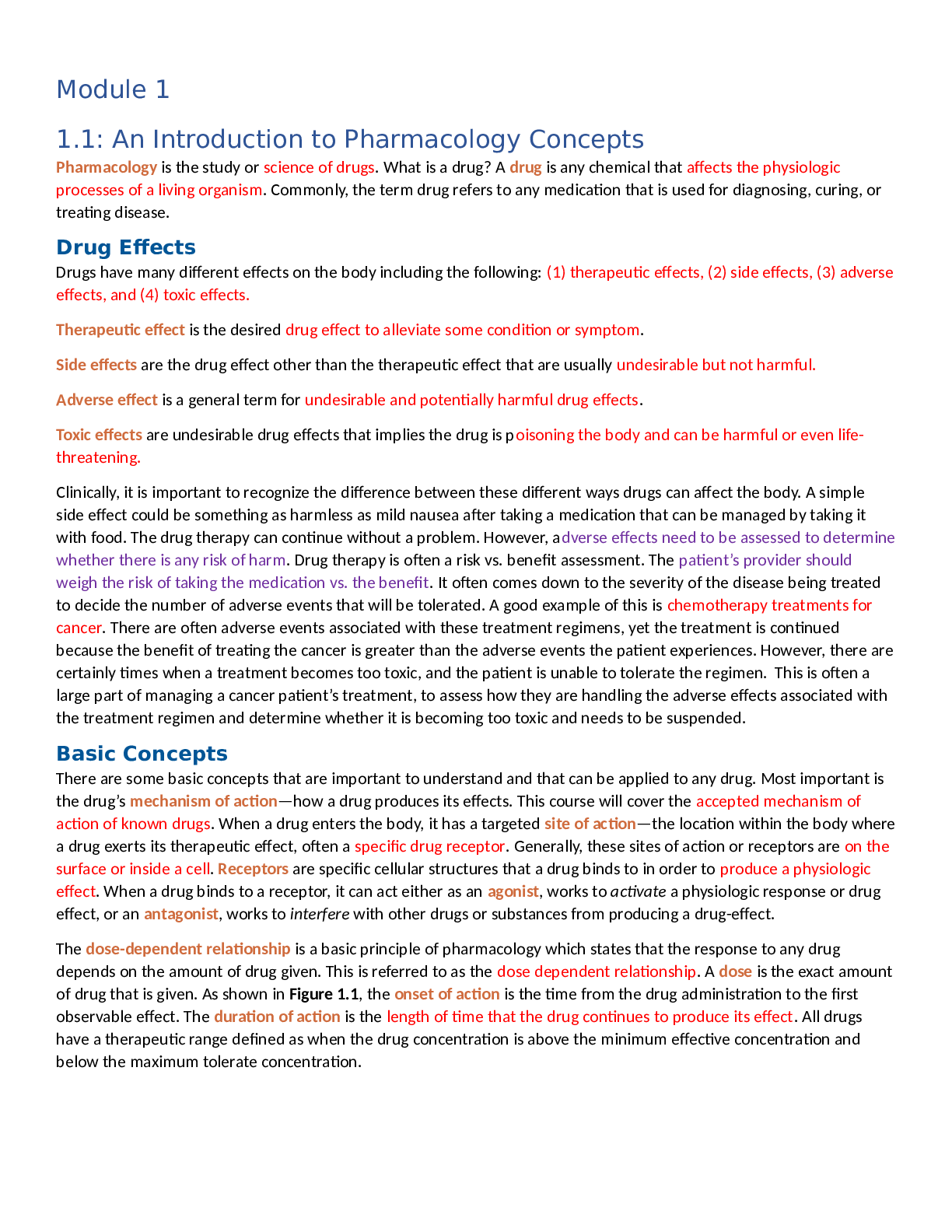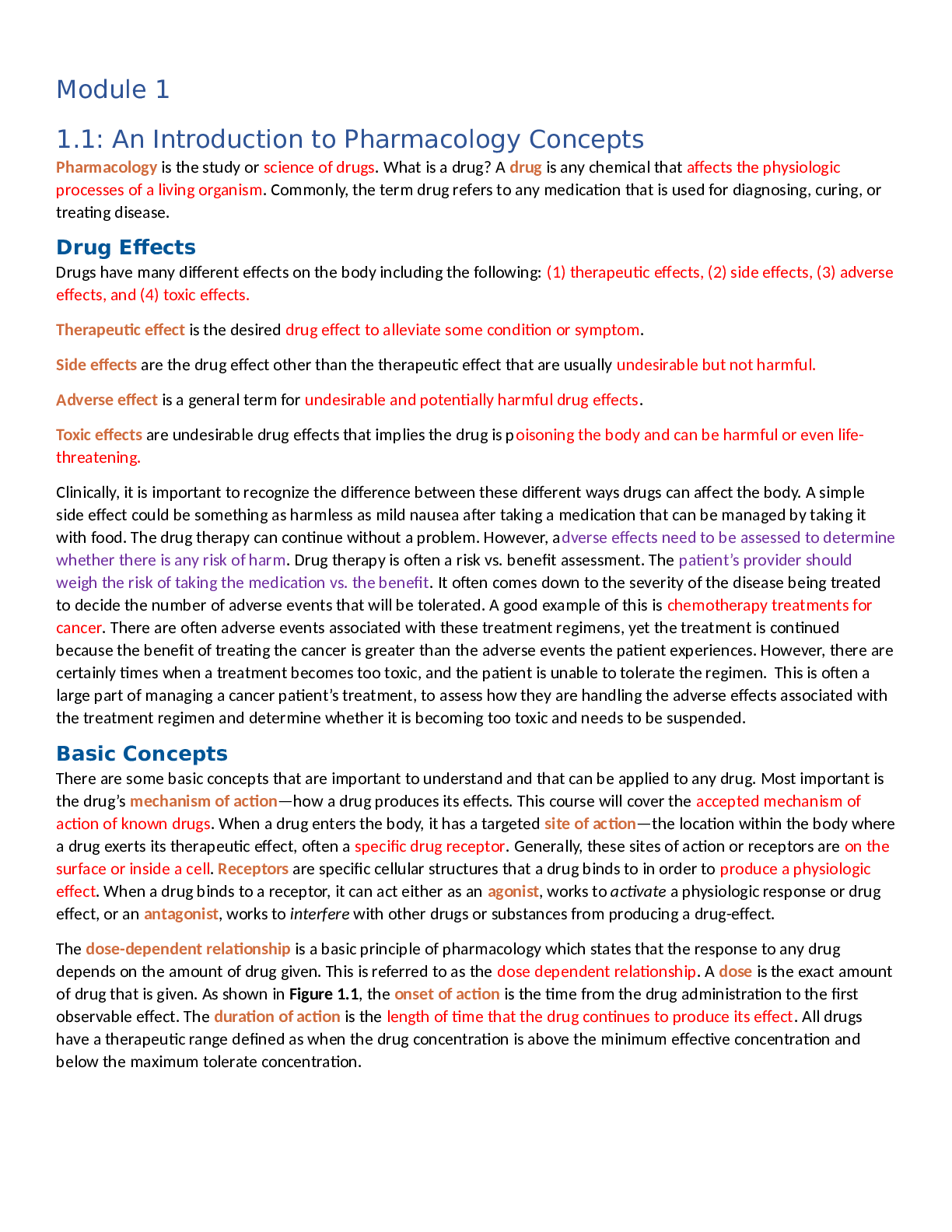An Introduction to Pharmacology Concepts
Pharmacology is the study or science of drugs. What is a drug? A drug is any chemical that affects the physiologic
processes of a living organism. Commonly, the term drug refers to any medication that is used for diagnosing, curing, or
treating disease.
Drug Effects
Drugs have many different effects on the body including the following: (1) therapeutic effects, (2) side effects, (3) adverse
effects, and (4) toxic effects.
Therapeutic effect is the desired drug effect to alleviate some condition or symptom.
Side effects are the drug effect other than the therapeutic effect that are usually undesirable but not harmful.
Adverse effect is a general term for undesirable and potentially harmful drug effects.
Toxic effects are undesirable drug effects that implies the drug is poisoning the body and can be harmful or even lifethreatening.
Clinically, it is important to recognize the difference between these different ways drugs can affect the body. A simple
side effect could be something as harmless as mild nausea after taking a medication that can be managed by taking it
with food. The drug therapy can continue without a problem. However, adverse effects need to be assessed to determine
whether there is any risk of harm. Drug therapy is often a risk vs. benefit assessment. The patient’s provider should
weigh the risk of taking the medication vs. the benefit. It often comes down to the severity of the disease being treated
to decide the number of adverse events that will be tolerated. A good example of this is chemotherapy treatments for
cancer. There are often adverse events associated with these treatment regimens, yet the treatment is continued
because the benefit of treating the cancer is greater than the adverse events the patient experiences. However, there are
certainly times when a treatment becomes too toxic, and the patient is unable to tolerate the regimen. This is often a
large part of managing a cancer patient’s treatment, to assess how they are handling the adverse effects associated with
the treatment regimen and determine whether it is becoming too toxic and needs to be suspended.
Basic Concepts
There are some basic concepts that are important to understand and that can be applied to any drug. Most important is
the drug’s mechanism of action—how a drug produces its effects. This course will cover the accepted mechanism of
action of known drugs. When a drug enters the body, it has a targeted site of action—the location within the body where
a drug exerts its therapeutic effect, often a specific drug receptor. Generally, these sites of action or receptors are on the
surface or inside a cell. Receptors are specific cellular structures that a drug binds to in order to produce a physiologic
effect. When a drug binds to a receptor, it can act either as an agonist, works to activate a physiologic response or drug
effect, or an antagonist, works to interfere with other drugs or substances from producing a drug-effect.
The dose-dependent relationship is a basic principle of pharmacology which states that the response to any drug
depends on the amount of drug given. This is referred to as the dose dependent relationship. A dose is the exact amount
of drug that is given. As shown in Figure 1.1, the onset of action is the time from the drug administration to the first
observable effect. The duration of action is the length of time that the drug continues to produce its effect. All drugs
have a therapeutic range defined as when the drug concentration is above the minimum effective concentration and
below the maximum tolerate concentration.
Figure 1.1 The change in plasma drug concentration over time. The Therapeutic range represented by the area between the
Minimum tolerated concentration (MTC) and Minimum effective concentration (MEC). Cmax is the maximum concentration, and tmax is
the time it takes to reach the maximum concentration. The time the drug is above the MEC is the duration of action. If the drug
concentration goes above the MTC, it is considered the toxic range. Similarly, if the drug concentration is below the MEC, it is in the
ineffective range.
Nomenclature
All drugs are chemicals, and many have long chemical names that define the chemical composition of the drug. In
addition, they are given a shorter non-proprietary name or generic name. The generic name, also known as a nonproprietary
name, is the name that we will use for assessments throughout the course. Drugs are marketed under a
trade name, also called a brand name, by pharmaceutical companies under a patented proprietary name specific to that
manufacturer. These names may be somewhat confusing because more often than not, one manufacturer will market a
medication that leads to multiple trade names for the same pharmaceutical compound. For example, the common blood
pressure medication, lisinopril, is marketed under both Prinivil and Zestril.
Beyond this basic nomenclature system, it is important to know that drugs also fall into categories called drug classes.
Drug classes represent a group of drugs that all work by a common general mechanism of action. They may have slight
differences in their effect on the body in terms of effectiveness or side effect profile; however, generally drugs within the
same drug class have many of the same characteristics.
Dosage Forms and Routes of Administration
Drugs are prepared in various forms for administration. The physical and chemical properties of the drug determine
which form will be most effective. All drugs have the active ingredient, the drug itself, and inactive ingredients that help
facilitate the administration and absorption of the drug. Common dosage forms are described in Table 1.1 below
Read More


